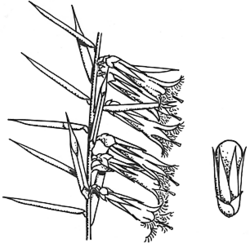Leucopogon fletcheri subsp. fletcheri Maiden & Betche APNI* 
Description: Densely branched shrub to 1.8 m high; branchlets scabrous.
Leaves oblong-linear, 3.7–8 mm long, 1.4–3.1 mm wide; apex acute, tip pungent to 1.0 mm long; base truncate; margins entire or minutely toothed; lamina thin, convex, striate-ribbed on lower surface; petiole to 0.3 mm.
Flowers pendent, mostly solitary plus rudiment, but occasionally in 2 or 3 (particularly in the Springwood-Winmalee area), in spikes crowded at end of branches, white; recurved peduncles to 1.5 mm long; bracteoles 1.2–1.6 mm long. Sepals 3.4–4.6 mm long. Corolla tube 3.5–4.8 mm long, sparsely pubescent above middle; lobes erect at base, 2.4–3.8 mm long; ovary 1–1.9 mm long; style 5.4–7.9 mm long.
Fruit obovoid, 4.7–5 mm long.
Distribution and occurrence: Grows in woodland, often on lateritic soils. Known from the lower Blue Mountains in the Springwood - Winmalee areas; South Maroota - Kenthurst; and Yengo National Park.
NSW subdivisions: CC
Threatened species: NSW BCA: Endangered
Text by J. M. Powell, except for groups with contributors listed. Updated by A.E. Orme, Aug 2023, with information provided by DPE Threatened Species Officer, Matt Saunders.
Taxon concept: Flora of NSW 3 (1992)
APNI* Provides a link to the Australian Plant Name Index (hosted by the Australian National Botanic Gardens) for comprehensive bibliographic data
***The AVH map option provides a detailed interactive Australia wide distribution map drawn from collections held by all major Australian herbaria participating in the Australian Virtual Herbarium project.
|


